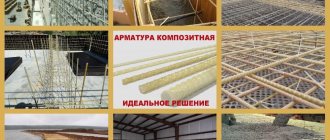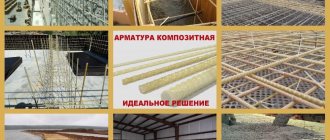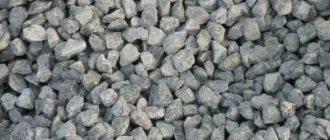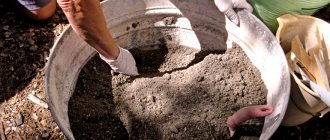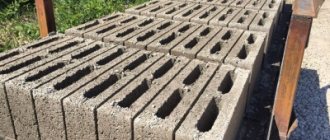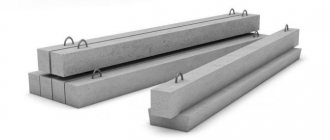Beton-House.com
Website about concrete: construction, characteristics, design. We combine the experience of professionals and private craftsmen in one place
Sulfur asphalt concrete
Sulfur concrete is a modern composite material, which is based on inert aggregates and fillers that perform the functions of a structural frame, and a binder—technical sulfur with modifying additives (see video in this article).
Sulfur, in its essence, is a thermoplastic. That is, composites made on the basis of this substance, including sulfur concrete, are thermoplastics.
- Fillers
Features of the composition of sulfur concrete
The basis of sulfur concrete is made up of inert fillers, as well as aggregates that act as a reliable structural frame. Technical sulfur is used as a binder. Essentially, sulfur is a thermoplastic, so concrete made with its addition can also be called thermoplastic.
However, it is impossible to simply introduce sulfur into a concrete solution for several reasons:
- Due to the increased fragility of solid sulfur. It begins to crumble even with slight pressure. This means that the finished concrete will be brittle.
- Due to the flammability of the material. However, such properties appear in sulfur only in direct contact with fire.
Therefore, only modified sulfur can be used for building mixtures. There are several methods for modifying it:
- Physical. Structure-forming fillers are added to the composition.
- Temperature Sulfur undergoes phase changes in properties as the temperature increases and decreases.
- Chemical. Stabilizers and plasticizers are added to the molten sulfur.
The chemical modification method is most often used. Thanks to additives, it is possible to regulate the properties of liquid mixtures and set the necessary characteristics that concrete will have after hardening.
Healthy! Sulfur concrete must comply with GOST 25246-82, which refers to chemically resistant concrete.
Four types of additives can be added to sulfur concrete:
- Fire retardants. Necessary to reduce flammability.
- Antiseptics. Protect the mixture from biological effects.
- Plasticizers. Significantly reduce fragility parameters and prevent the process of sulfur crystallization.
- Stabilizers. Allows you to increase the resistance of the material to atmospheric changes.
Thanks to such additives, it is possible to create different types of building materials.
Astrakhan awaits OPP
However, it should be noted that the properties of sulfur concrete, to a greater extent than in the case of cement concrete, depend on compliance with the technological process and quality control of input raw materials at all stages of production. Currently, sulfur-based building materials in our country are produced by small companies, usually in artisanal conditions. These industries can tarnish the reputation of sulfur-based materials. As a result of this amateurish approach and the lack of precise equipment capable of regulating the heating of the mixture within plus or minus 1 degree, “handicraft” sulfur concrete can, upon reaching a temperature of 150 degrees, emit hydrogen sulfide and sulfur dioxide - gases that have a nerve-paralytic effect and pose a threat for a person. Therefore, the creation of production facilities that can produce large volumes of sulfur concrete in strict accordance with technological standards is of particular relevance.
It is in this direction that Gazprom Sera is now moving. At the first stage, the task is to create a functional complex of pilot industrial production (PIP). On its basis the following will be carried out: development of compositions and production of SMV, mixtures of sulfur concrete and sulfur asphalt, development of technologies for the production of materials and structures based on sulfur, design and industrial testing of structures, materials, machines, equipment. The company's employees are currently carrying out R&D and developing regulatory and technical documentation related to the production of new types of products, and it is also planned to train specialists who will later be involved in the production of materials and structures from sulfur. In short, it will be a research and educational center, a testing ground and a production enterprise all rolled into one. According to the Deputy Head of the Department of Marketing, Processing of Gas and Liquid Hydrocarbons of OJSC Gazprom, General Director of Gazprom Sera Marat Garayev, “The EPP is expected to be equipped with the latest equipment based on environmentally friendly and man-free technologies. The main types of manufactured and sold products will be granulated SMV (currently developers are targeting volumes of about 120 thousand tons per year, which can be increased over time), sulfur concrete and sulfur asphalt mixtures, slabs for covering temporary and permanent roads, square piles with non-stressed fittings covering gas pipeline weights. All types of structures will be manufactured strictly in accordance with GOST.”
To date, Gazprom Sulfur specialists, together with the LENNIIIGIPROKHIM Institute, have prepared a feasibility study, investment justification and basic technical solutions for each of the production facilities. A competition to select a designer for the enterprise is due to take place in the near future. Design and entry to the construction site should be completed this year, and commissioning of the enterprise is expected in 2016. Astrakhan is planned to be its location, and in the future it is expected that such enterprises will appear in Orenburg.
Types of sulfur concrete and types of aggregate
There are no fewer varieties of sulfur concrete than classical concrete. The most popular types are:
- Hydrophobic sulfur concrete. It repels water well, which is why it is often used when installing foundations on “wet soils.”
- Foamed sulfur concrete. A type of cellular concrete with increased chemical resistance and reduced thermal conductivity.
- Sulfur concrete hardens quickly. To achieve nominal strength characteristics it takes from 2-3 minutes to 2-3 hours.
The performance of sulfur concrete and its scope of application is also influenced by the type of aggregate chosen. Most often, crushed stone up to 40 mm in size is added to gray cement as a coarse aggregate. If it is necessary to create a particularly heavy mixture, then metal shavings are added (lead shot can also be used). In the process of producing lightweight concrete, porous aggregates are required that meet the standards of GOST 32496-2013. These include expanded clay or shungizite gravel, various slags, as well as agloporite crushed stone. Natural quartz sand (enriched, fractionated, crushed) is used in the form of fine-grained aggregate.
Fiber can also be used as a filler when reinforcement of sulfur concrete is required. Any type of fiber can be used to make fiber-sulfur concrete. It should contain about 5-7% of the volume of sulfur. Glass, polyester and other fibers are suitable as fiber. As a result, it is possible to create high-strength structures that will surpass conventional concrete in their characteristics.
Kazan "Tiocomposite" intends to buy all the sulfur from oil refineries
How a Kazan company learned to use sulfur residues in the road construction and construction of protective structures
Every year, global oil and gas processing generates about 70 million tons of sulfur. Of this, 50 million tons are consumed as raw materials for the production of sulfuric acid, fertilizers, plant protection products and other chemicals. Accordingly, 20 million tons remain unclaimed. In the regions of the Middle East alone, where the best oil is produced, by 2016 more than 12.5 million tons of sulfur surplus had been accumulated. In regions where high-sulphur oil is produced, in particular the USA and Canada, these numbers are even more significant. The question is, where to put all this accumulated “good”? Answer: the largest capacity in terms of consumption of surplus could be the industry of road construction and the construction of protective structures. Kazanskaya declares its readiness to take away all the excess sulfur generated in the republic during the processing of our viscous high-sulfur oil, that is, 300 thousand tons of the mineral.
Backward Russia
The topic of using sulfur in construction, admittedly, is not new. Whatever it is, it fits well with the meaning of the saying about the well-forgotten old things. For the first time, concrete, where sulfur was used as a binder - one of the two main components of the material, was produced back in the 30s of the last century. In the 70s, the topic experienced a renaissance - at this time, American and Canadian road builders began to use sulfur concrete as an alternative to traditional asphalt concrete. Later, Japan showed interest in the product, which, in particular, began to actively use the material in the production of sewerage and water supply systems. Relatively recently, newcomers began to enter the market - the UAE, Saudi Arabia, Iran, Turkey: there sulfur concrete is also used in the construction of sewerage systems, water supply and water pipelines.
Source: CRU, GTIS
Russia is not yet present in this market, although in the post-Soviet space the topic is being pursued by about 40 scientific groups, whose participants have now defended many candidate and doctoral dissertations. Due to the almost complete absence of innovation companies—intermediaries between scientists and enterprises—the material never entered large-scale production. Today, Kazan-based Tiocomposite LLC, created in 2014 as a joint venture between the Nanotechnology Center of the Republic of Tatarstan and the Kazan Automobile Vans Plant, declares its readiness to act as a connecting link.
"Magic" supplement
Briefly about the technology itself. In the production of sulfur concrete, it is not sulfur as such that is used, but a sulfur copolymer - a substance obtained using modifiers, the chains of molecules of which consist of many structural units.
In its basic properties, sulfur concrete is superior to traditional concrete made from Portland cement - it is resistant to acids and alkalis, which are widely used in the production of road deicing agents, does not absorb water, and therefore is not afraid of the so-called “zero crossing” ", it does not care about salt water, it is plastic, and in addition, it can be painted, thus imitating more noble natural materials, for example, granite, marble or patina. Experts say that concrete with such properties can be made using Portland cement, but here the question of price/quality ratio arises.
In addition, the process of producing sulfur concrete is much less metal- and energy-intensive than the production of traditional concrete structures: the latter are first formed in special forms, then either kept for 28 days or processed in special steaming chambers; in this case, the “maturation” period is reduced to 10 days. In the case of sulfur concrete, a ready-to-use structure can be removed from the formwork within an hour.
The process of producing sulfur concrete is much less metal- and energy-intensive than the production of traditional concrete structures. Photo serobeton.com
Finally, sulfur concrete can be made from industrial waste, for example, from quarry screenings, the only current purpose of which is the reclamation of quarries and mineral deposits or ash and slag waste. What is important is that sulfur concrete itself is subject to recycling: used structures are crushed, melted and then reused.
However, simply copying existing technologies makes no economic sense - the equipment manufacturer, as a rule, also produces modifiers with the help of which sulfur is converted into a sulfur copolymer.
Experiment site
General Director of Tiocomposit Evgeniy Khramov, a physicist by training, first took up the topic of sulfur copolymers back in 2004, when he worked as a researcher at KFU. At that time, however, the issue of their use in the rubber industry was studied. Subsequently, the range was expanded, and Khramov and his colleagues (many of them work in the company today) began working on the use of sulfur copolymers in the production of building materials. This work lasted for almost 12 years. By the time the company was created, Khramov and his colleagues already had developments that could be safely introduced into mass production.
Characteristics of sulfur concrete and comparison with cement concrete
At temperatures from +15 to +20 degrees, sulfur is a solid crystalline substance with low electrical and thermal conductivity. It is not able to dissolve in water. Moreover, sulfur can create bonds with almost all elements of organic and inorganic type. It melts at +120 degrees, and if you raise the temperature to +445 degrees, then only in this case the sulfur will begin to boil.
If we compare the characteristics of sulfur concrete and conventional building mixtures, it turns out that:
- The compressive strength of sulfur concrete reaches 102 MPa, while for cement concrete the maximum value is 40 MPa.
- The tensile strength of mixtures with added sulfur is 5.5 times higher (22 MPa).
- The bending strength of ordinary concrete is no more than 7.5 MPa, and that of sulfur concrete reaches 30 MPa.
- The curing time for conventional concrete is 28 days. Sulfur concrete requires a maximum of a few days.
- Sulfur concrete has lower thermal conductivity.
- Cement concrete has a rather low chemical resistance rating. If an additive in the form of sulfur is used, the material acquires the necessary stability.
Also, sulfur concrete is 100% waterproof, so even with absolute humidity, the frost resistance of the structure increases by 500-600%. Therefore, it is not surprising that such more modern compositions have a huge number of advantages.
Sulfur on the roads
How natural gas is produced
Chairman of the Company's Management Board Alexey Miller spoke about the complex effect of the new Gazprom innovation project at a meeting of the Presidium of the Russian Presidential Council for Economic Modernization and Innovative Development on May 17, 2013. He explained that “the main limiting factor for increasing production at the Astrakhan and Orenburg fields is the significant amount of sulfur released from gas in conditions of limited demand for it in foreign markets and in the domestic market. Our institutes have developed technologies for modifying asphalt based on sulfur, which can increase the strength and plasticity of asphalt, increase the time between repairs of roads to 5-7 years with a significant economic effect for road construction... this technology could, in our opinion, give a triple effect. Firstly, reduce the environmental load in Astrakhan and Orenburg, where very large volumes of sulfur have accumulated. Secondly, to increase the profitability of gas production at these fields. And thirdly, significantly improve the quality of roads, especially in regions with sharp temperature changes, and also reduce the cost of road construction.”
The method of modifying bitumen with sulfur itself is not new and received its first industrial use 100 years ago, but large-scale work in this direction in our country and abroad began only in the 1970s. In 1986, the USSR even issued “Instructions for the use of sulfur additives in hot asphalt concrete mixtures.” Due to well-known events, the further development of these projects in Russia stalled and they did not reach practical implementation, but Gazprom picked up the baton. In 1998, Gazprom VNIIGAZ began research on the use of sulfur in road construction, and for the first time sulfur asphalt concrete was laid in October - December 2002 during the repair of the road surface of the bridge in Krylatskoye. The work was carried out in extreme conditions (rain, snow, sub-zero temperatures), and the final part was carried out at temperatures below minus 20 degrees, when laying conventional asphalt concrete was virtually impossible. In June 2010, sulfur asphalt concrete was laid on the 50–51 km section of the Moscow Ring Road, which required 558 tons of material. The site safely withstood even extreme summer heat. Thus, the qualitative superiority of sulfur asphalt, which is produced by adding SMV to bitumen, over traditional road surfaces was experimentally confirmed.
At present, the advantage of using SMB in road construction is beyond doubt, and it is no coincidence that at the above-mentioned meeting, the Chairman of the Government of the Russian Federation, Dmitry Medvedev, instructed the Ministry of Transport to work with Gazprom on the implementation of a number of pilot projects for the construction of roads from sulfur asphalt concrete in regions with different temperature conditions.
Advantages of sulfur concrete
In addition to the obvious superiority over conventional concrete and excellent characteristics, it is worth highlighting:
- low price of the composition;
- processing of sulfur concrete structures for recycling;
- resistance even to very aggressive environments;
- the ability to quickly gain strength even at low temperatures;
- increased wear resistance.
Healthy! Due to its dielectric characteristics, sulfur concrete is often used instead of polymer concrete, since its cost is 3-4 times lower.
But it also has its drawbacks. For example, it is very difficult to prepare sulfur concrete at home, since for the mixture the sulfur will have to be melted at a temperature of more than +140 degrees. To produce the material, installations are required, the cost of which can reach up to 12 million rubles. The equipment will also ensure safe production, as hydrogen sulfide is released during the process.
Gazprom enters the construction materials market
What can be made from natural gas
The value and economic efficiency of innovations invariably increase when, thanks to their use, it is possible to simultaneously solve several problems at once. Such an example is the Gazprom project to develop and implement the production of sulfur modified binder (SMB), as well as materials and structures based on it. The implementation of this project will allow Gazprom to overcome the production difficulties that arise when producing gas from high-sulfur fields, while simultaneously ensuring the creation and development of a new promising sub-industry in Russia related to the production of construction materials.
Scope of application
Typically, sulfur concrete is used in areas where high-strength structures or coatings that quickly gain strength are needed. Therefore, this type of concrete has become widespread during installation:
- Prefabricated concrete structures such as curbs, foundation slabs, sleepers, power line poles, etc.
- Road surfaces of various types, including airport sites or roads in areas with low temperature conditions. Since sulfur concrete is chemically stable, it is not destroyed by the reagents used and other compounds present on such coatings.
- Underground structures. For example, sulfur concrete is excellent for the construction of pile foundations, fences, tunnels, and walls in manholes. The building material is also used in the construction of buried structures, such as storage facilities for non-combustible bulk materials.
- Gravity or pressure sewer pipes, pipelines. At the same time, not only ordinary, but also toxic wastewater can flow through them.
- Floors in warehouses, industrial and other buildings.
- Roofs (top floors), the slope of which can reach up to 2.5%. At the same time, sulfur concrete can be used for buildings of any type and purpose.
- Load-bearing and enclosing structures with fire resistance class V.
- Various types of coverings (slabs, decking, frames, purlins).
This building material is also widely used when it is necessary to dispose of waste. Sulfur concrete molecules can literally cement or trap particles of various radioactive wastes. Therefore, this material is used for their burial. Some metals contain oxides that actively interact with modified sulfur and therefore do not penetrate into the environment. Thus, sulfur concrete can be used to dispose of cadmium, mercury and other hazardous substances.
This material is also used to impregnate highly porous concrete in order to improve their properties. Sulfur concrete can be used to repair cracks and other defects in finished products and structures. But for each application, it is necessary to choose the right composition, since sulfur concrete can also be heavy, light, and other types.
Abroad will help us
The main problem for the production of sulfur fiber reinforced concrete is the lack of necessary equipment in Russia. It is produced by a joint company AGT GMBH (Germany) and Sell (Netherlands). A plant for the production of sulfur fiber reinforced concrete SCPP 10 with a capacity of 24 t/h costs approximately 2.2 million euros.
Of course, the cost of the plant is quite significant - few road construction organizations can afford it. However, for the same money, road construction companies in the Republic of Tatarstan purchased asphalt mixing plants (APS) made in Germany. It should be taken into account that their operating time is limited to the construction season (maximum 4 months), while the SCPP 10 plant can produce sulfur fiber reinforced concrete products all year round. Since components from local producers and industrial waste are used in its preparation, the cost of road products will be significantly cheaper than those made from cement concrete. Coupled with high quality, this allows sulfur fiber reinforced concrete to be a competitive material for highways of all categories, the road network of cities, settlements and on-farm roads.
Rinat Gubaev
IndustryPetrochemicalsTechnologyBusinessTransportSocietyInfrastructurePower Tatarstan
Marking of sulfur concrete
When designing objects, it is necessary to clearly understand what characteristics the finished structure will have. If we take into account the average density of the composite material, it can be of several categories:
- Extra heavy sulfur concrete. The density of the material is more than 2.8 g/cm3. Such formulations may be grade D2500 or higher. Also, such mixtures must indicate the SbS O classification.
- Heavy (SbS T). The density of the composition should be in the range of 1.8-2.8 g/cm3. Marked D2000-D
- Light (SbS L). Density indicator less than 1.8 g/cm3. Accordingly, the marking will be from D800 to D
Healthy! You can also read more about the classification of sulfur concrete and technical standards for its use in PNST 105-2016.
The material is also classified according to workability. Accordingly, the mobility group, strength index and sometimes the level of frost resistance should be indicated. Based on this, sulfur concrete is marked:
- F – hard;
- P – movable;
- L – cast.
According to the strength class, serocement can be:
- durable (marked from B10 to B60);
- high-strength (marking more than B60).
Suppose we are talking about a mobile mixture that will be used for the production of heavy concrete with strength class B25, frost resistance F2200 and water resistance class W4. In this case, the marking will be as follows: SbS T-P-V25 F2200 W4.
Preface
- 1 DEVELOPED by the Limited Liability Company “Small Innovative Enterprise “Sulfotex MADI” (LLC “SIP “Sulfotex MADI”)
- 2 INTRODUCED by the Technical Committee for Standardization TC 465 “Construction”
- 3 APPROVED AND ENTERED INTO EFFECT by Order of the Federal Agency for Technical Regulation and Metrology dated August 10, 2022 No. 699-st
- 4 INTRODUCED FOR THE FIRST TIME
The rules for applying this standard are established in Article 26 of the Federal Law of June 29, 2015 N9 162-FZ “On Standardization in the Russian Federation”. Information about changes to this standard is published in the annual (as of January 1 of the current year) information index “National Standards”, and the official text of changes and amendments is published in the monthly information index “National Standards”. In case of revision (replacement) or cancellation of this standard, the corresponding notice will be published in the next issue of the monthly information index “National Standards”. Relevant information, notices and texts are also posted in the public information system - on the official website of the Federal Agency for Technical Regulation and Metrology on the Internet (www.gost.ru)
©Design. FSBI "RST". 2021
This standard cannot be fully or partially reproduced, replicated and distributed as an official publication without permission from the Federal Agency for Technical Regulation and Metrology
Content
- 1 area of use
- 2 Normative references
- 3 Terms and definitions
- 4 Technical requirements
- 5 Acceptance rules
- 6 Control methods
- 7 Safety and environmental requirements
Appendix A (mandatory) Method for determining the mobility of sulfur concrete mixture
Bibliography
f W
and
